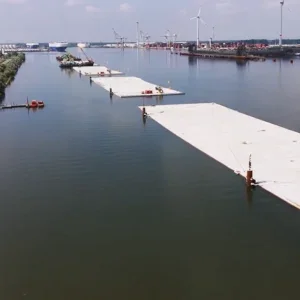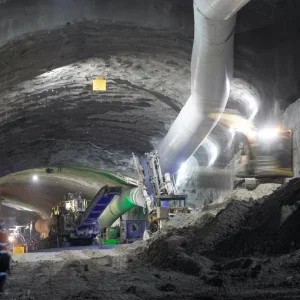In Vancouver, the Seli-SNC Lavalin JV, InTransitBC, has completed the Canada Line bored tunnels ahead of schedule (T&TNA, Mar 2007, p13).
On March 02, the project’s 440 tonne TBM broke through into what will eventually be the Canada Line’s Waterfront Station. The event marks the completion of two side by side bored tunnels using a Lovat 20ft (6.1m) diameter mixed face EPBM from just south of False Creek to just north of Pender Street in downtown Vancouver.
The 1.52-mile (2.45km) long drive was started in mid-2007 and was scheduled to take 10 months to complete along a route consisting of sandstone, glacial till with granitic boulders with a high watertable. The tunnel internal diameter is 17.5ft (5.3m) and the alignment sees the depth vary between 23ft and 98.5ft (7m and 30m) below the city surface. Completion of this second tunnel means the 2nd Avenue worksite can now be transformed from servicing the tunnel construction to construction of the station.
British Columbia Premier Gordon Campbell said: “This breakthrough represents an important milestone for this project, which will significantly improve transit service for people throughout the Lower Mainland.” Applauding what is arguably a greater achievement than finishing ahead of schedule, Premier Campbell added: “I want to congratulate all of the workers for their hard work and dedication and for completing this critical phase of the Canada Line without a single lost-time injury or accident.”
When complete, the Canada Line rapid transit system will run fully separated from traffic between a transportation hub at the Waterfront Centre to Vancouver International Airport. The scheme features 16 stations, two bridges, 11.8-miles (19km) of tunnel and elevated guideway, parking and bus facilities to give a transit capacity equivalent to 10 road lanes. Designed as a commuter line with a secondary function for airport transit, it is widely perceived as being a key infrastructure component for Vancouver’s hosting of the 2010 Olympic and Paralympic Winter Games. In reality, the link has been planned for several years and in fact the Olympic hosting dates are more of a driver to avoid construction during the event.
The Can$1.9 billion project is funded by the federal government, the Province of British Columbia, the Greater Vancouver Transportation Authority (TransLink), the Vancouver Airport Authority and the City of Vancouver. InTransitBC is the private sector partner and is responsible for the design, construction, partial finance, maintain and operation of the system. It also assumes most construction and operation risks. This approach was chosen to give access to private sector innovation and efficiencies, whilst giving the private partner an incentive in a long-term successful transit system. It also ensures ownership of the line remains in public hands.
Lawrence Cannon, Federal Minister of Transport, Infrastructure and Communities said: “This successful project clearly demonstrates the benefits of public-private partnerships in large-scale transportation infrastructure projects.” Whilst praising the site teams, TransLink chair, Dale Parker, was also looking forwards when he said: “Every one of them can be proud of this amazing accomplishment and with the Premier’s massive transit program, it’s exciting to realize we will be celebrating many more “breakthroughs” for Metro Vancouver’s transit system in the coming years.” n
The Lovat EPBM breaks through in downtown Vancouver The Lovat EPBM breaks through in downtown Vancouver







